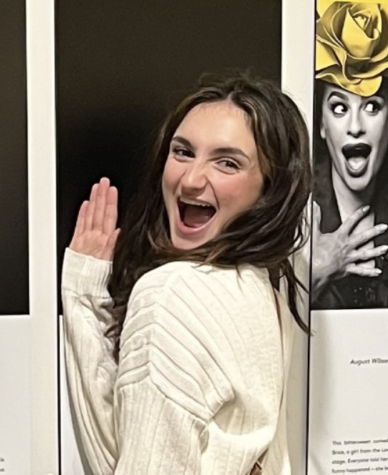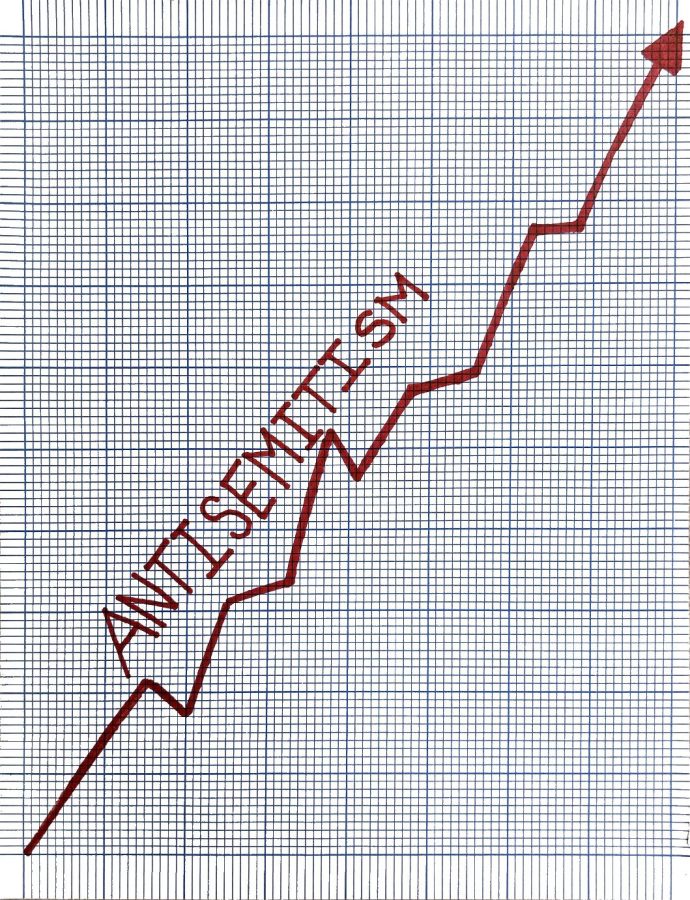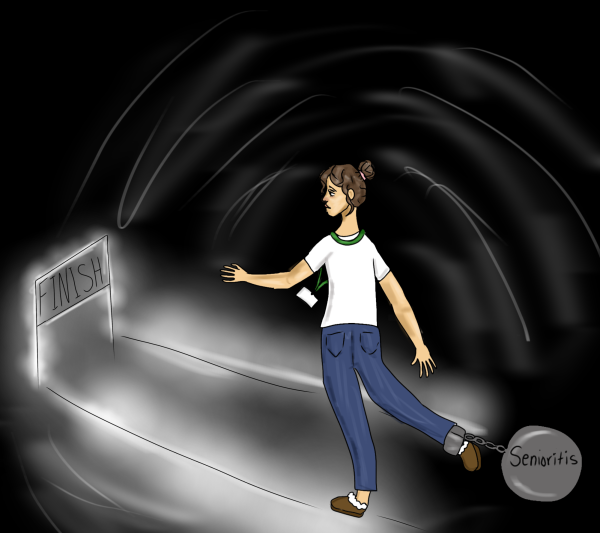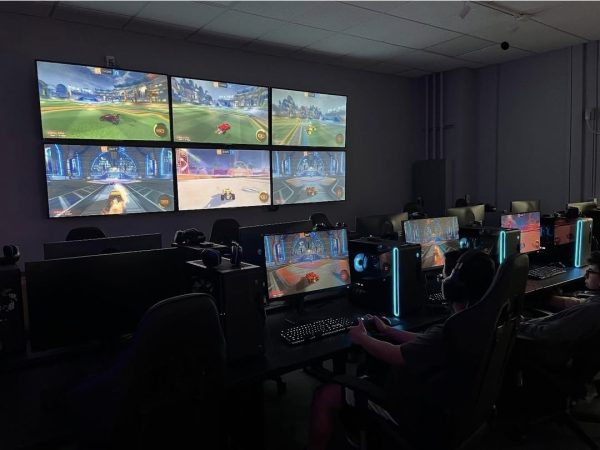How Do We Fight the Recent Rise in Antisemitism?
Jewish people being used as a scapegoat for the Black Death occurred from 1347-1351. The Holocaust occurred from 1933-1945. Kanye West’s tweet that he would wake up and “go death con 3 on Jewish people” occurred on October 9, 2022. These are three separate and significant examples of blatant antisemitism. The larger issue at hand is uncovering why antisemitism is still a rampant disease infecting society.
First, what is antisemitism? Antisemitism is the discrimination of or against Jewish people, either solely for being Jewish or playing off stereotypes about Jewish people. It is the hatred of Jewish symbolism or anything religious to the Jewish faith. Antisemitism has many forms, ranging from a seemingly innocent comment about one’s Jewish friend to a serious hate crime. The ignorance of antisemitic slurs, the lack of respect for Jewish holidays, and more seemingly insignificant actions add up to the overall crisis of continuous antisemitism.
Acts of antisemitism are taking place nearly everywhere, from school bathroom stalls to the burning of synagogues or temples. Sophomore Chloe O’Callaghan recalled that swastikas on school property are nothing new, referring to both the swastika carved into a tree at South Middle School and the one drawn in an LHS stall in December. “We’ve seen swastikas in the bathroom, and this isn’t my first time seeing swastikas in school,” O’Callaghan said. Antisemitic acts take place on social media as well. “I’ve experienced hate comments on Instagram,” sophomore Gabe Lewner shared. “I’ve had family members have [antisemitic] things said to them, and I’ve seen acts of protest [against Jewish people] in the city.”
But why are people antisemitic? What gives people the authority to advertise their hate for Jewish people? Jewish people are overall both an ethnic and religious minority. Walking into a HomeGoods in December, one might see a shelf or two of Hanukkah decorations, while the rest of the store is all Christmas-themed decorations, toys, and apparel. The products we consume are ruled by the Christian faith and the traditions that stem from it. Checking into a hotel room, the top drawer of the nightstand is likely going to have a Holy Bible, but the chance of seeing any Jewish religious text is slim. The more that people believe their own religion or race is the majority, the more Judaism gets pushed down.
Additional fuel to the antisemitism that is seen especially in America is the crisis in the Israel/Palestine area. In 1948, Israel became an independent country and a haven for Jewish people after the Holocaust. However, there were territorial disputes, as Palestine, a predominantly Muslim nation, and Israel overlap. Now, as Benjamin Netanyahu rises to power in Israel, more people are becoming aware of the chokehold that Israeli nationalists have on Palestinians. The people who are only consuming pro-Palestinian and anti-Zionist media are slowly going to become more antisemitic, while only certain people in government are contributing to the issues in Israel and Palestine.
Social media content is another factor that perpetuates antisemitism. Many more alt-right influencers on TikTok, YouTube, Instagram, and other platforms are pushing their personal beliefs on naïve young minds. TikTok is the main culprit for this, as its algorithm is so specifically curated to each user. TikTok users have done tests and experiments to see how quickly the videos they like will lead them to the “alt-right pipeline,” and it has happened in a matter of under 30 minutes. Say a teenager likes one video in which a slightly antisemitic joke is made; that one seemingly harmless joke will gradually turn into video after video of increasingly antisemitic beliefs, and the user may not even realize it.
The lack of regulations on social media sites like Twitter are allowing posts advertising antisemitism, letting threats of potential hate crimes go unnoticed. It is only until a vast majority of users beg the platform to do something about the post that action will be taken. The most recent and relevant example of this is Kanye West; In October, West tweeted that he would “go death con 3 on Jewish people,” and a few weeks later had had the audacity to post “Shalom :).” It took days for Twitter to remove the tweet, then even more days after that for Twitter to shut down West’s account. It took Adidas three days to cut ties with West, ceasing production of West’s shoe line, Yeezys.
While brands neglecting to remove people off their platforms is contributing to the rise in antisemitism, people continuing to support antisemitic influencers also adds to the problem. There are many debates in the music and art industry of whether one can or should separate the art from the artist. In some instances, it would be okay to still listen to a music artist after he or she did something slightly stupid. However, advertising support for West or flaunting being in the top 0.001% of his listeners from Spotify Wrapped is promoting antisemitism. It is proving that it is okay to still give money to and support the livelihoods of antisemitic people.
Giving celebrities platforms and refusing to remove them from their platforms is a major part of the issue. Young brains are susceptible to receiving and learning hate more than others. “It’s the celebrities who are voicing their opinions and coming out against the Jews. People who are listening to them are being brainwashed instead of listening to the facts,” Lewner said. Kanye West is not the only celebrity culprit who has made antisemitic remarks: basketball star Kyrie Irving made comments as well. Sophomore Justin Haberman thinks that specifically those two celebrities have especially fueled the recent rise in antisemitism. “They make it seem like it’s ok to be antisemitic,” he said.
In the end, what kind of environment is antisemitism even creating? Certainly not a positive one. Jewish people may be filled with fear, anger, and exasperation. “It’s been hard to know that I can go outside and people would have a reason to hate me, attack me, or do worse things just because I’m Jewish,” O’Callaghan said. O’Callaghan expressed feelings of anxious waiting of what is next to come, either for them individually or for the Jewish community as a whole. “The recent carvings in the tree and the swastikas at school have made it clear that antisemitism is closer than I would ever think it would be and it is scary,” Haberman shared.
Although nearly impossible to fully stop a problem as widespread and historically engrained as antisemitism, as a society, action can be taken to slow it down. The first step is education. Teach children young about Jewish holidays, how they are celebrated, and why their Jewish friend and his/her family may be fasting. Then, brands need to take more accountability, monitor what is on their sites more, and increase their guidelines. Social media sites can run more background checks on users to ensure that they are contributing to a positive online community, not a negative and hateful one. With monitoring comes the help of parents, teachers, and adults, who can teach kids both young and old how to find non-biased sources for research or projects, as well as how to navigate social media without falling down a rabbit hole of misinformation or hate speech.
“It’s never going to be a perfect world where we’re all accepted, but if we help educate people more on the consequences and the effects that their words and actions have on other people, and really put it into their perspective to make them learn the best they can, [that is] really the best thing we can do,” O’Callaghan expressed.

Hey there! My name’s Gianna, and I’m a member of the Class of 2025, along with many clubs here at LHS. In my spare time, you can find me on the stage,...








































